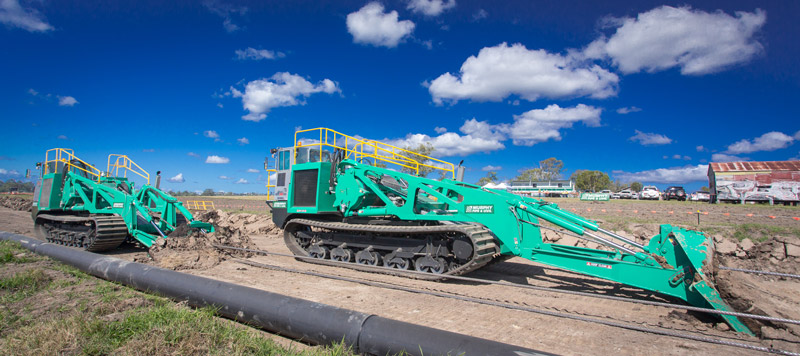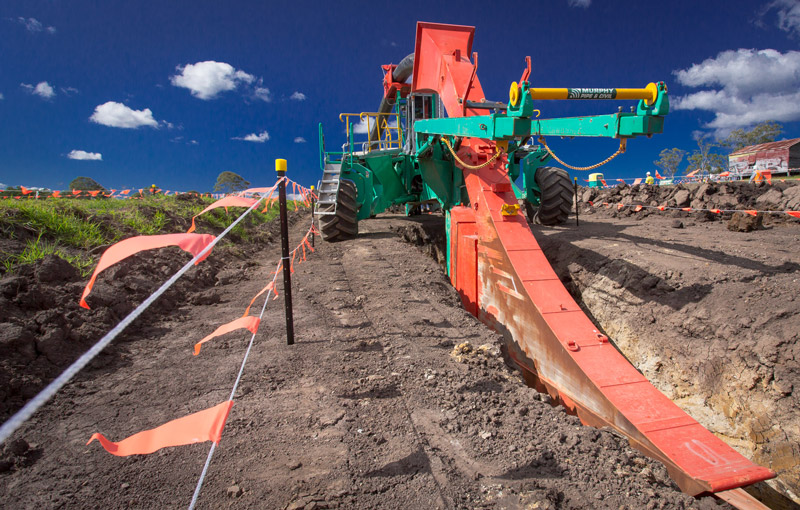Murphy Pipe and Civil is one of the winners to emerge from Queensland’s CSG boom. Ron Horner takes a look at the company and its innovative pipe-laying equipment
 |
|
The plough systems are capable of installing HDPE pipelines up to 630mm across the most challenging terrain
|
Now that the dust has settled on Queensland’s coal seam gas (CSG) boom and the big boys have packed up their toys and gone home, it’s a good time to catch up and have a look at just what was delivered in the largest infrastructure programme to hit the state.
One of the rags-to-riches stories to come out of the CSG boom is the rise of a new player in the Australian pipeline industry – Murphy Pipe and Civil (MPC Group) – and how it changed the industry landscape.
 |
|
The German-designed and -made Foeckersperger Spiderplough pipelayer
|
Company background
The precursor to MPC, Pipe and Civil, was created in central Queensland in 2005 by three workmates – Tom Dermody, Jim Campbell and Brenton Euler – who had similar ideals and contrasting experiences in the industry.
At the time the three were working on Queensland’s Burdekin pipeline.
In 2008 Pipe and Civil begin construction on the $42 million Yea to Yarra Glen Pipeline as part of the Sugarloaf Pipeline Alliance.
The innovation, speed and quality of the work pushed out by this small company proved to be the catalyst to project it into a new league of pipelining in Australia.
The big break that Pipe and Civil was looking for was provided when it was awarded the contract to complete a $123 million steel pipeline for MCC Mining on the Sino Iron project in Western Australia’s Pilbara region.
The company says it was its investment in a fleet of industry-changing equipment – the Foeckersperger Spiderplough and Fast Fusion welding technology – that led to its first principal contractor role.
So successful was this move that Pipe and Civil secured almost $150 million of contracts in the first year, which attracted great interest in pipeline circles throughout the world.
Murphy Group, the UK’s largest pipeline company, just happened to be in Australia at this particular time and was sourcing possible partnering arrangements with other large-scale Australian-based civil companies in an effort to break into the Queensland CSG pipeline market in 2010.
Murphy had many ex-employees working in Australia and it didn’t take long for the company to hear about Pipe and Civil’s successful WA venture and secure a meeting with the directors.
In 2011 the two companies merged to become Murphy Pipe and Civil, and a new era in Australian pipelining started.
 |
|
Two Foeck Crawler FWF92 winch vehicles use cables to pull the plough
|
Feeling the heat
CSG fields are made up of an intricate web of multiple high-density polythene (HDPE) pipes which run underground from the well head. It was rumoured that there could be up to 15,000km of these pipes required to fulfil the requirements for all the CSG fields, and Pipe and Civil felt it could corner a fair share of the market.
Using typical pipeline construction methodology, the HDPE pipe is strung along the pipeline and just off centre line. The pipe is then heat-welded together with specialised HDPE pipe-welding machines, forming a super-strong moulded, welded joint.
An excavator with a grab attachment lifts the strung pipe from the ground and into the frame of the welding machine where the end is trimmed and bevelled automatically. It is then moved forward in the frame and the next length of pipe is placed using the same procedure.
When the ends are trimmed and bevelled, a pre-heated steel plate is inserted between both the pipes as they are squeezed together. This action of squeezing the pipes onto the heated plate causes the HDPE pipe to melt at the ends and, when the consistency of the weld is achieved, the plate is removed and the pipes jacked together so as the hot melted material forms a welded joint.
This action of lifting, placing and welding of the pipe is a continuous process and, if multiple welding units are placed at intervals along the strung pipe, it is possible to achieve a significant run in quite a short timeframe.
 |
|
HDPE pipe welding machines form a super-strong joint
|
Game-changer
As mentioned above, Pipe and Civil was well ahead of the pack when it came to innovation. During the WA growth spurt, it had negotiated the purchase of six newly designed Spiderplough pipelayers from German designers and manufacturer Foeckersperger.
The German plant could only manufacture a couple of machines per year, which meant that Pipe and Civil ( and later MPC) could hold off any challenges from anyone hoping to move in and use this new method of HDPE pipe installation.
The Spiderplough is a purpose-built multi-functional unit that combines the three pipelining activities of digging, laying and backfilling into one.
During the pipe installation, the plough is pulled by dozers equipped with winches and blades that act as anchors; here one or two Foeck Crawler FWF92 winch vehicles are used depending on the existing ground conditions.
Once in motion, the plough’s ripper and pipe-insertion unit are pulled through the ground. The previously strung and welded HDPE pipe is continuously laid as the machine moves forward to the specified depths of up to 2.5m.
Unlike open trenching systems, the narrow slot in the earth created by the plough is quickly closed and compacted down. The movement of the unit is guided by the use of GPS technology to enable precise placement of the pipe and is proven to deliver up to 10km of pipe insertion in one shift laying 300mm HDPE pipe.
 |
|
A sword on the Foeck FSP220 plough forms and clears the laying bed at specific depths up to 2.5m
|
Success through innovation
The merging with Murphy’s brought international pipeline experience and a massive cash injection to Pipe and Civil, which allowed the new boys on the block to gain access to many lucrative pipeline contracts.
British Gas had bought out QGC, the first of the CSG projects to get underway and, as Murphy had worked with them back in the UK, it provided an excellent reference base to again provide their services.
Since 2011, Murphy has secured many hundreds of millions of dollars of CSG contracts in Queensland, won numerous safety and innovation awards, introduced new technology not before seen in Australia, and worked with manufacturers to patent safety and production improvements to their equipment.
Despite being fined and receiving a four-year ban from sponsoring overseas workers after a 457 visa scandal a few years ago, the company is recognised worldwide as being up there with the best on offer and is operating in several countries … the latest being the US, where it bought a Dallas-based pipeline company and is introducing the trenchless pipe-laying technology to the Americans.
The company has successfully laid more than 3500km of HDPE pipe in the 160mm-450mm range for the CSG industry and has proven to be a first-class operator.

